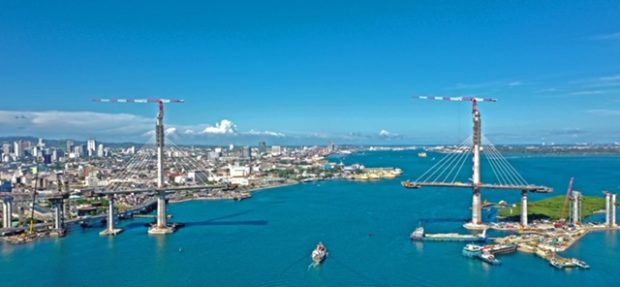Cebu bridge a highlight in 500-year history of PH role in world’s 1st circumnavigation

Cebu-Cordova Link Expressway. MPTC Photo
MANILA, Philippines — The soon-to-be-completed 8.5-kilometer Cebu-Cordova Link Expressway (CCLEX) has been chosen as one of the key sites related to what’s been dubbed as an “epic milestone” – the quincentennial anniversary of the first circumnavigation of the world.
The CCLEX, which is now in its final stages of construction, spans the Mactan Channel linking Cebu City with the Municipality of Cordova and outlying towns of Cebu Province. According to CCLEX builder Metro Pacific Tollways Corporation (MPTC), the “iconic” tollway bridge was selected by the National Quincentennial Commission (NQC) “among history-making structures built-in time for the half-a-millennium anniversary when the Philippines loomed large in the world’s map.”
“Through this tollway bridge, we are happy enough to be part of the vision of accelerating the progress and modernization of the entire Cebu province,” Rodrigo E. Franco, MPTC President and CEO said in a statement on Wednesday.
“We are doubly glad that – through CCLEX – we have key participation in the celebration of the 500th year of the Philippines’ key role in the first circumnavigation of the Earth. This happens only once in our own lifetime,” Franco added.
Reflecting on this bit of history, the MPTC chief shared: “As always, when people travel, they enter new frontiers and discover new cultures, open trading posts, and forge commercial partnerships and alliances.”
“Today,” he added, “this CCLEX bridge will do the same – stimulating commerce and industry, facilitating cross-currents of culture, and further accelerating development.”
500th anniversary of Magellan’s landing
In commemoration of the arrival of Ferdinand Magellan’s Spanish fleet, the Armada de Molucca, in the country 500 years ago, the Spanish training ship Juan Sebastián Elcano arrived on March 16, Tuesday, at the Suluan waters in Guiuan, Eastern Samar.
Since October 2020, the Spanish Navy ship has been tracing the same exact route taken by the Magellan-Elcano expedition for the first circumnavigation of the world in 1521.
READ: Spanish ship to reenact circumnavigation of globe
According to historians, the Magellan-Elcano expedition that sailed from Seville, Spain, in 1519 crossed the Atlantic, Indian, and Pacific Oceans.
Magellan and his crew then dropped anchor off the uninhabited Homonhon Island, then known as Humumu, on March 16, 1521, where they stayed for eight days before proceeding with their journey to what is now known as the Philippines.
Juan Sebastián Elcano is set to sail from Eastern Samar to Cebu on Thursday, March 18. It is expected to pass by CCLEX – the third Cebu-Mactan bridge – on Saturday, March 20, through Mactan Strait.
READ: As quincentenary celebrations near, Spanish navy ship to pass Cebu this March 20
READ: Homonhon set for quincentenary of Magellan’s landing
More Quincentennial celebrations
Aside from being acknowledged as a part of the celebration of the 500th anniversary of the first circumnavigation of the world, the CCLEX will also play a crucial role in the NQC’s celebration of the 500 years of Christianity in the Philippines and the 500th anniversary of the Victory of Mactan in April.
The CCLEX’s eight 40-meter-high crosses, which MPTC said was inspired by the Magellan’s Cross, is set to be installed and illuminated by hundreds of LED strip lights before the historic commemoration of the country’s 500 years of Christianity on April 15.
READ: Myths and facts about the Magellan-Elcano circumnavigation of the globe
“The cross above CCLEX is a symbol of celebration. The crosses, having no corpus or body, is ecumenical (universal, all-embracing),” said Fr. Mhar Balili, secretary-general of the Archdiocese of Cebu’s 500 Year of Christianity celebration.
“With the cross-shaped structures lit up above the twin pylon of CCLEX, we are honored to become part of the commemorations of a historical chapter in the lives of our countrymen,” said MPTC’s Franco.
The crosses will be lit once again on April 27 as part of the celebration for the 500th Anniversary of the Victory of Mactan.
“The lighting of the CCLEX crosses will also be integrated into several other events such as the drone show and cultural show, and the grand fireworks display at the Liberty Shrine in Lapu-Lapu City, Cebu,” MPTC said in a statement.
‘Engineering marvel’
The P30-billion CCLEX project of the Cebu Cordova Link Expressway Corp. (CCLEC), a subsidiary company of MPTC, is hailed as an engineering marvel due to its “aesthetically designed structures and modern tollway management systems.”
The major infrastructure project aims to ease congestion in the country’s second-busiest urban center. It will have two lanes in each direction that will provide a safe, quick, and scenic passage to an estimated 50,000 vehicles daily, easing the traffic in two old bridges – the Marcelo Fernan Bridge and the Mandaue-Mactan Bridge.
“CCLEX has a design speed of 80 kilometers per hour (kph) and a navigational clearance or height of 51 meters to allow large vessels to pass underneath the bridge,” said MPTC.
According to a recent update by the CCLEC, the completion of the project is now at 68.21 percent, while the construction progress is now at 59.68 percent.